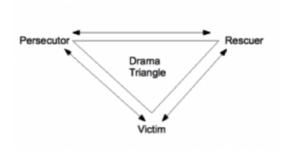You do it for the right reasons. You keep information from your boss because you're afraid he'll blow up. You let a non-performing employee get by with it because  she's had a rough year. Instead of confronting disruptive behavior from the bully in the workplace, you let it slide because she's a star performer.
she's had a rough year. Instead of confronting disruptive behavior from the bully in the workplace, you let it slide because she's a star performer.
The people in your workplace might be different, and the reasons might vary, but the situation is the same: You are the rescuer, and when you rescue, you contribute to the drama and workplace conflict.
In my book, Stop Workplace Drama, I introduce a tool, called The Karpman Drama Triangle. The idea is that when there is dysfunction you will see three roles being played out as illustrated by the diagram below.

Do you notice a theme in rescuing? It's justification. You have good reason for WHY you rescue. It's going to hurt someone's feelings. Someone has had a bad year. She's a star performer. To leave the rescue role, you must first identify the patterns.
Here are seven ways identify rescuing patterns:
How to Identify Rescuing
- Difficulty saying "no"
- Resentment toward others
- Hiding the truth to protect others
- Control freak
- Constant need to fix other people's problems
- The need to be the hero
- Doing other people's "emotional work."
If you want to stop your own rescuing patterns here are four practical steps you can take:
How to Stop Rescuing
- See the pattern you create by your thinking.
- Be willing to face the part you play in contributing to the dysfunction.
- Start seeing others as capable and competent.
- Contribute by building their skills through training, coaching and feedback, rather than rescuing.
[box] Points to Ponder:
What is the difference between rescuing and helping?
How often do you hide information to protect someone?
What do you get out of always being the hero?[/box]


